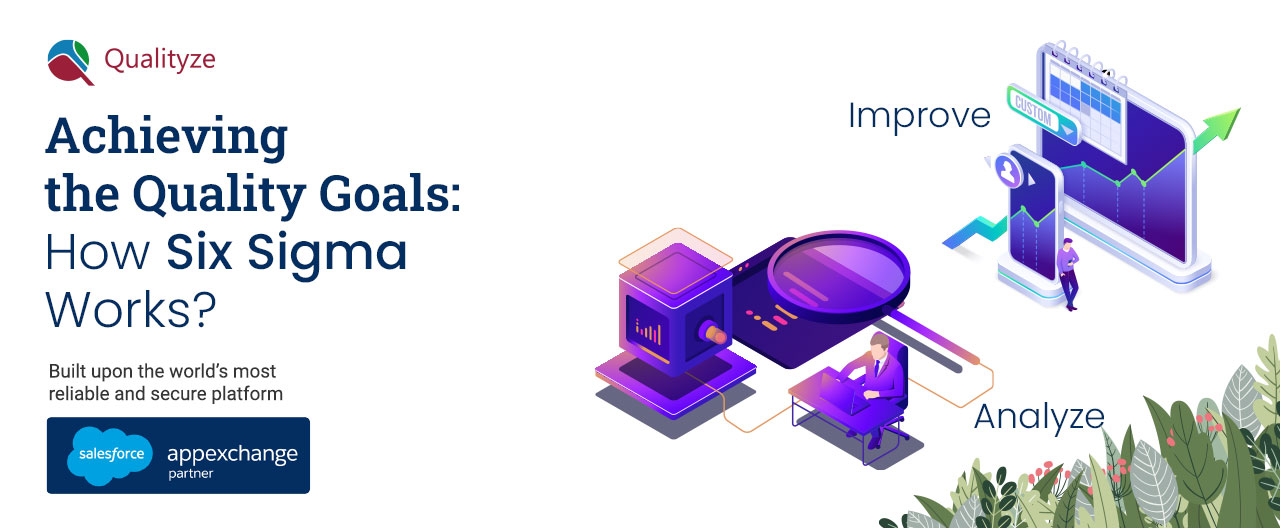Products
Industries

Whether an organization succeeds or fails largely depends on the quality of its products and services. In the long run, you will not be able to survive if you ignore an important aspect like quality. Six Sigma aims to eliminate defects in processes and systems to ensure superior quality of products.
Organizations use six-sigma to identify, analyze, and remove the obstacles that hinder them from reaching perfection by analyzing and eliminating their processes and systems. In this post, we will learn more about the six-sigma methodology, its benefits for the organization, and its role in quality management.
In Six Sigma, errors or defects are analyzed statistically and based on data. It focuses on improving cycle times while reducing manufacturing defects.
The Six Sigma methodology is a data-driven approach to streamlining production and manufacturing. You can also leverage this most flexible project management and process improvement method for industries and businesses outside of manufacturing.
A business can use Six Sigma tools to eliminate defects and improve processes to boost profits. In the 1980s, a Motorola scientist developed it.
A Lean Six Sigma approach focuses on eliminating waste and defects while improving work standardization to improve performance. Lean Enterprise combines Six Sigma methodologies and tools with lean manufacturing to reduce waste in manufacturing and organizational processes while ensuring quality. Using resources that do not create value for your customers is a waste of resources.
Six-sigma defines five simple steps for process improvement wherein you need to;
Also Read: Explain the Five-Why Analysis to Determine Root Cause(s)
Six Sigma can drive multiple benefits:
Six Sigma aims to decrease your company’s total waste by optimizing processes. Your organization will save time, money, and resources by identifying and resolving waste within your organization.
By leveraging Six Sigma, you are not only able to reduce waste but also improve your efficiency. In addition, having formal training will help you maximize the effectiveness of your current business processes.
Quality and process are equally important to Six Sigma. The best way to save money and time is to get your product right first!
As good as it sounds, the same process will save you money and prevent legal expenses. The Six Sigma methodology is dedicated to quality, making it an excellent choice for organizations trying to comply with international standards.
Almost any industry can benefit from Six Sigma. No matter what industry you work in – healthcare, manufacturing, retail, higher education – it can help! Any company can reduce costs and increase profits by leveraging the skills and tools you gain from your training.
Even though money can’t buy happiness, it can buy a nicer thing! You can save a lot on product recalls by identifying improvement opportunities with six-sigma.
Therefore, the six sigma methodology sounds like a win-win-win situation.
Six Sigma strives for defects and waste elimination in all business processes, thereby enhancing quality and efficiency. The sigma rating measures how many products are defect-free. It is expected that 99.99966% of all production opportunities will be defect-free in a six-sigma process. Health care organizations use Six Sigma to ensure that delivering health care services is as reliable as possible. However, it was initially designed to increase manufacturing efficiency for General Electric in 1995.
Using Six Sigma, you can identify and eliminate defects (errors) in your processes and minimize inconsistencies. The new system uses quality management methods and creates a particular infrastructure within the organization of people who are experts in them (“Champions,” “Black Belts,” “Green Belts,” “Yellow Belts,” etc.).
Six Sigma emphasizes identifying and correcting the root causes of variations with statistical tools and analysis. In Six Sigma, DMAIC stands for Define, Measure, Analyze, Improve, Control as a framework for problem-solving and process improvement. Most companies use six-sigma as a part of their CAPA process to identify the root causes of the defects and nonconformances reported.
However, manually managing the entire process may present many challenges, especially in fast-paced business environments. Therefore, it would be best to use CAPA management software that gives you complete flexibility to choose the investigation tools based on your business and compliance requirements.
Qualityze CAPA Management enables enterprises to standardize CAPA workflow with necessary investigation tools. The software supports a variety of means, including – 5 whys, Six Sigma, Fishbone, and much more. In addition, it automatically stores CAPA records in a centralized database so you can quickly trace the details during inspections or audits.
Qualityze CAPA Management, built on Salesforce.com, has many exceptional in-built capabilities such as digital signature, audit trail, email approvals, and more. You can experience the Qualityze difference to improve quality by requesting a free demo.
For more queries, please get in touch with our customer success team at info@qualityze.com, or you can call us at 1-877-207-8616, and our team will get back to you as soon as possible.